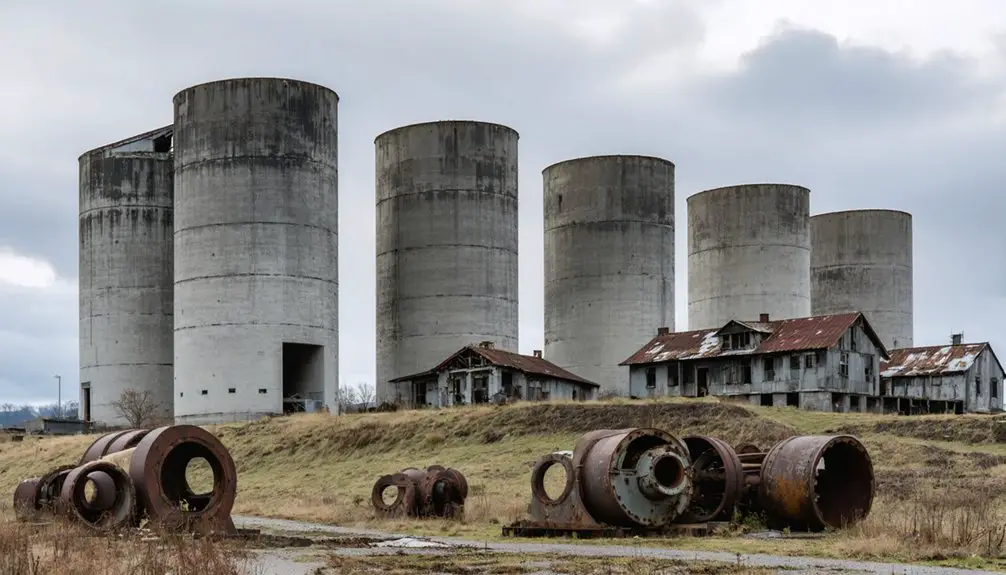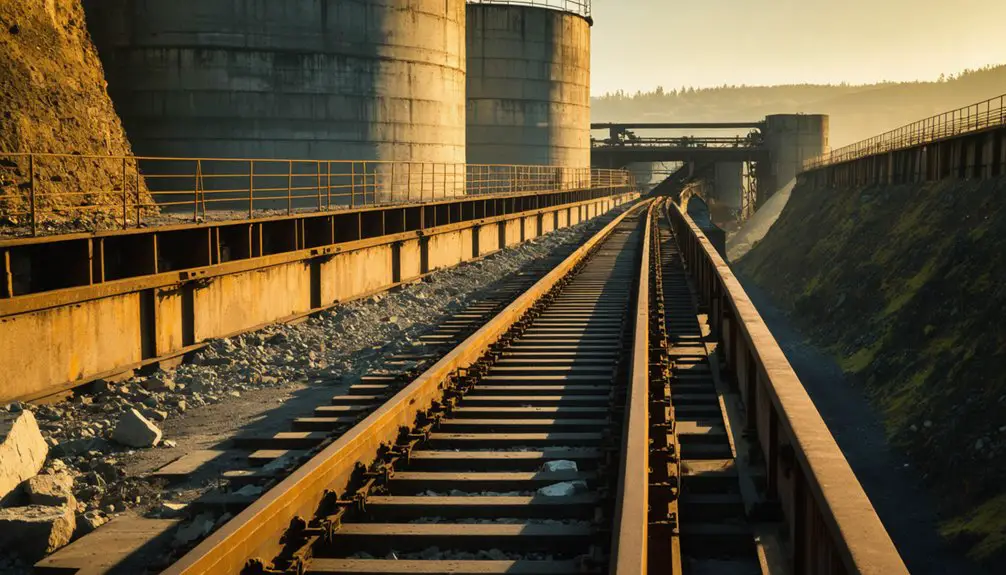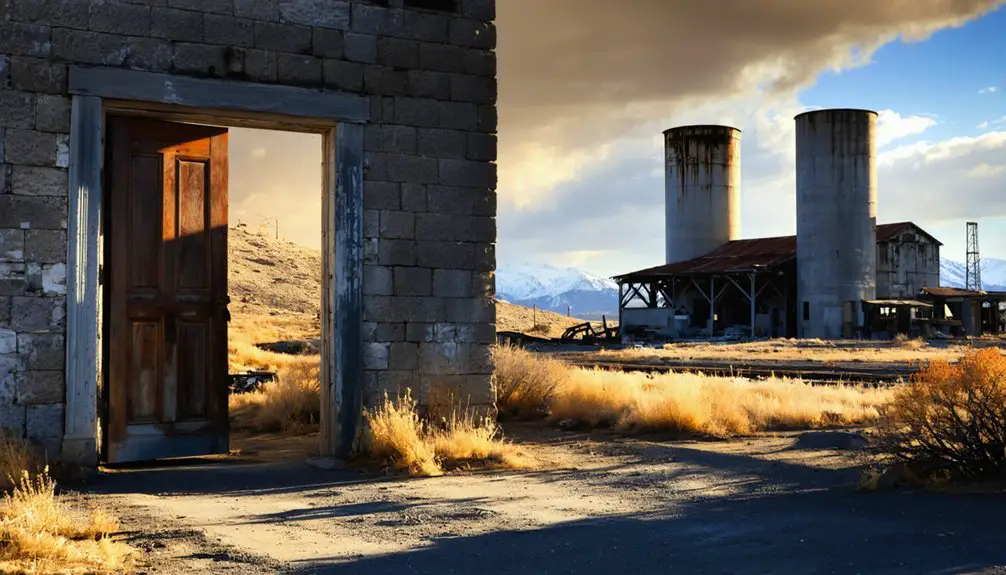You’ll find Lime, Oregon as a haunting reminder of Eastern Oregon’s industrial past. Founded in 1899 around rich limestone deposits, this company town flourished under Sun Portland Cement Company’s operation from 1921-1980, producing 1.2 million barrels annually at its peak. While demolition in 2018 removed most structural remnants, the abandoned schoolhouse still stands as the last witness to this once-bustling cement empire. Its crumbling ruins hold untold stories of Oregon’s industrial golden age.
Key Takeaways
- Lime, Oregon began as a limestone mining and cement production town in 1899, reaching peak production of 1.2 million cement barrels annually.
- The town operated as a company town around the Sun Portland Cement Company, with workers dependent on company housing and stores.
- Operations ceased in 1980 due to market challenges and depleted limestone deposits, leading to the town’s abandonment.
- The cement plant structures remained as urban exploration attractions until their demolition in 2018.
- Only the abandoned schoolhouse remains today as the last significant structure marking Lime’s industrial history.
The Birth of a Limestone Legacy
When geological fortune placed vast limestone deposits in Eastern Oregon’s landscape, the small settlement of Lime emerged in 1899 to harness this valuable resource.
You’ll find the town’s origins deeply rooted in the Triassic Martin Bridge Limestone formation, created by ancient reef-building organisms around tropical volcanic islands some 150 million years ago. Similar to the Amedee Lime Works that shipped limestone to Reno, this unique limestone geology became Eastern Oregon’s industrial cornerstone, as the town’s founders recognized its potential for lime production.
The Acme Cement Plaster Company established operations in 1916, marking a significant expansion of the town’s industrial capabilities.
The historical significance of Lime’s location wasn’t just about minerals – it sat near the Oregon Trail, connecting the region’s pioneer past with its industrial future.
While the community remained small, its establishment marked the beginning of essential industrial development that would supply both Eastern Oregon and Western Idaho.
Industrial Powerhouse Years
As Lime entered the industrial age in 1916, the Acme Cement Plaster Company established the town’s first plaster plant, marking the beginning of a six-decade industrial boom.
The town’s industrial growth transformed rapidly when Sun Portland Cement Company took over in 1921, shifting operations to Portland cement manufacturing and building new facilities.
You’ll find Lime’s peak production years defined by these achievements:
- Output reached 1.2 million barrels annually by the 1960s
- Cement supplied major projects like the Owyhee Dam
- Rail infrastructure connected products to broader markets
- Operations expanded through the Oregon Portland Cement merger
Despite maintaining just 18 residents by 1940, Lime’s community identity centered on its industrial prowess, with efficient transportation networks and abundant limestone deposits fueling its success through the 1970s.
The limestone deposits in the surrounding area made the location ideal for cement production.
The facility eventually succumbed to economic pressures, leading to its closure in 1980.
Life in a Company Town

If you’d lived in Lime during its heyday, you’d have followed routines common to company towns, with your daily schedule revolving around the cement plant’s shifts and the whistle that marked key times throughout the day.
You’d have found your social circle shaped by the town’s layout, where housing assignments often grouped workers by job position and background, creating tight-knit neighborhood networks. Your purchases would have been limited to the company store where prices were often inflated due to the monopolistic nature of these establishments.
Your community bonds would have been strengthened through company-sponsored gatherings at the town hall and shared activities with coworkers who, like you, depended entirely on the cement company for both employment and basic services. This system of employer control was typical of company towns, where business leaders viewed paternalism as their moral duty to shape workers’ lives.
Daily Routines and Work
Life in Lime revolved entirely around the cement plant’s demanding operations, where workers endured long shifts of heavy industrial labor in limestone quarrying and cement production.
Most employees made the daily commute from nearby Huntington rather than living in Lime itself.
Worker safety remained a constant concern as you’d navigate hazardous conditions while operating heavy machinery and handling industrial materials.
Your daily challenges would’ve included:
- Extracting and crushing limestone during daylight hours
- Managing multiple production lines for both plaster and Portland cement
- Coordinating rail shipments of finished cement barrels
- Maintaining complex machinery throughout extended shifts
You’d find yourself part of a small, tight-knit workforce that kept the plant running at peak capacity, producing up to 1.2 million cement barrels annually during the 1960s.
Just as British sailors relied on citrus to prevent scurvy during long voyages, workers depended on their routines and safety protocols to survive the grueling conditions.
The work was relentless, requiring specialized skills and unwavering attention to maintain production levels.
Social Support Networks
Beyond the physical demands of cement production, Lime’s small population of just 18 residents at its peak in 1940 created an intimate social fabric where everyone depended on one another.
You’d find community resilience in the way residents banded together, sharing resources and support through the town’s limited institutional framework centered around the post office and schoolhouse.
Despite social isolation typical of company towns, you could count on your neighbors when times got tough. The cement plant’s work schedules shaped daily interactions, while company-provided housing kept everyone in close proximity.
This tight-knit arrangement lasted until economic changes and resource depletion began fracturing these bonds. When the post office closed in 1964, it marked the beginning of the end for Lime’s social support networks, ultimately leading to the community’s dissolution.
Engineering Marvels and Regional Impact
You’ll find Lime’s most impressive engineering achievement in its cement plant, which incorporated continuous kilns and advanced mechanical systems capable of producing 1.2 million barrels annually at peak capacity.
The facility’s strategic design integrated local limestone deposits with efficient crushing and processing equipment, while leveraging the nearby Marble Creek and Burnt River for essential operations. The town’s 18 peak residents maintained these complex systems during the 1940s when production was at its height. Like many ghost towns in Oregon, Lime’s eventual decline came from diminishing profitability and resource depletion.
Your understanding of Eastern Oregon’s industrial development isn’t complete without recognizing how Lime’s cement production supported major infrastructure projects like the Owyhee Dam, demonstrating the plant’s vital role in regional construction advancement.
Cement Plant Engineering Innovations
The Lime cement plant’s engineering innovations marked a significant leap in regional industrial development when the Acme Cement Plaster Company constructed its initial facility in 1916.
The plant’s adoption of rotary kilns revolutionized cement production, enabling stronger and more consistent output while maximizing efficiency.
You’ll find these groundbreaking advances at the heart of Lime’s industrial success:
- Strategic placement near rich limestone deposits cut transportation costs
- Modular plant design allowed seamless switching between plaster and cement production
- Continuous processing systems replaced older batch methods, boosting productivity
- Advanced kiln technology improved combustion control and product quality
Infrastructure Legacy Impact Analysis
Standing as one of Oregon’s most significant industrial legacies, Lime’s cement plant infrastructure transformed eastern Oregon’s industrial landscape from 1916 until its closure in 1980.
You’ll find its impact reached far beyond local boundaries, with the plant’s 1.2 million barrel annual production supporting major projects like the Owyhee Dam construction.
The plant’s industrial heritage remained visible through its towering processing units and railway connections until 2018.
The infrastructure’s resilience was evident in its decades-long persistence as an industrial ruin, though this created safety challenges for the abandoned site.
While the physical structures are now gone, you can still trace Lime’s influence through its transportation networks, regional economic footprint, and the broader story of resource-dependent communities along I-84.
The Final Days of Production

During its final operational phase, Lime’s once-thriving limestone production steadily declined from its peak of 1.2 million barrels annually.
You’ll find that production challenges and market decline took their toll as competing mainland producers gained the upper hand with advanced technology and lower transportation costs.
Here’s what led to Lime’s final production days:
- Depleted limestone deposits forced workers to migrate to nearby mining towns
- Labor-intensive rock breaking methods couldn’t compete with mechanized operations elsewhere
- Temporary rail tracks and infrastructure fell into disrepair as production slowed
- Declining demand and quality of raw materials made kiln operations financially unsustainable
The workforce, which never exceeded 18 residents during the 1940s peak, dwindled as the operation wound down, leaving behind minimal remnants of its industrial past.
Tales From an Abandoned Empire
Once bustling with industrial activity, Lime’s abandoned cement empire now stands as a haunting monument to Oregon’s industrial past, where you’ll find crumbling concrete structures and weathered remnants scattered across its remote landscape.
After the plant’s closure in 1980, these industrial ruins became a magnet for urban exploration, drawing adventurers fascinated by the site’s rich history and eerie aesthetics.
You can trace the town’s decline through its deteriorating landmarks – the shuttered post office, the abandoned schoolhouse, and the massive cement plant that once produced 1.2 million barrels annually.
While industrial archaeology enthusiasts document these decaying structures near the Oregon Trail and Burnt River, the site’s unstable conditions and sharp edges make exploration hazardous, serving as a stark reminder of this once-thriving industrial community.
Preserving the Memory of Lime

While the 2018 demolition of Lime’s cement plant marked the end of its most visible industrial remnants, the town’s memory persists through scattered artifacts, photographs, and local folklore.
You’ll find the community’s legacy preserved through both formal and informal means, with the abandoned schoolhouse standing as the last major structural witness to Lime’s industrial past.
Today, memory preservation efforts continue through:
- Urban explorers documenting the site through photography and online sharing
- Local residents passing down stories of Lime’s role in regional development
- Historical records highlighting the town’s contribution to infrastructure projects
- Geological studies examining the limestone deposits that sparked Lime’s rise and fall
While formal preservation programs haven’t materialized, you’ll discover that Lime’s story lives on through the dedicated efforts of history enthusiasts and neighboring communities.
Frequently Asked Questions
What Happened to the Families Who Lived in Lime After Closure?
After 1980’s plant shutdown displaced 100% of workers, you’d see families scatter to nearby towns like Durkee and Huntington. Their family relocation marked the end of Lime’s community legacy, forcing career changes.
Are There Any Surviving Maps of Lime’s Original Town Layout?
You won’t find thorough maps of Lime’s original layout today. While railroad and USGS archives hold fragments showing historical significance during town expansion, no thorough maps from its operational period survive.
Did Any Accidents or Deaths Occur at the Cement Plant?
While you’d expect cement plant accidents at Lime’s hazardous facility, no specific fatal incidents are officially documented. The site’s deteriorating condition and danger warnings suggest deaths likely occurred but weren’t recorded.
What Native American Tribes Inhabited the Area Before Lime’s Establishment?
To sum it up, you’d have found the Kalapuya tribes inhabiting this region of Oregon. These Native tribes held historical significance in the Willamette Valley before being displaced by settlers and disease.
Were There Any Environmental Impacts From Decades of Limestone Mining?
You’ll find extensive environmental damage, including limestone erosion that permanently scarred geological formations, contaminated local waterways, disrupted wildlife habitat, and left behind abandoned quarries that altered natural drainage patterns near Marble Creek.
References
- https://www.outdoorproject.com/united-states/oregon/lime-cement-plant-closed
- https://architecturalafterlife.com/2024/02/abandoned-lime-schoolhouse-in-oregon/
- http://archive.lyza.com/2009/09/29/weekend-abandoned-cement-plant-in-lime-oregon/index.html
- https://travelingthepnw.com/2017/08/07/abandoned-lime-cement-plant/
- https://wickershamsconscience.wordpress.com/2022/10/30/geology-is-messy-lime-oregon/
- https://nvtami.com/2023/11/16/ghost-towns-highway-395-reno-to-lakeview/
- https://www.youtube.com/watch?v=4rhmW_0iT8A
- https://en.wikipedia.org/wiki/List_of_ghost_towns_in_Oregon
- https://socialwelfare.library.vcu.edu/organizations/labor/company-towns-1890s-to-1935/
- https://en.wikipedia.org/wiki/Company_town



